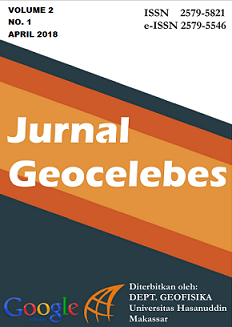KARAKTERISASI SERPIH PADA FORMASI TALANGAKAR SEBAGAI POTENSI SHALE HYDROCARBON
DOI:
https://doi.org/10.20956/geocelebes.v2i1.3563Abstract
Eksplorasi dan eksploitasi di Indonesia saat ini masih terfokus pada energi konvensional hidrokarbon dibandingkan energi nonkonvensional hidrokarbon seperti gas serpih. Gas serpih adalah salah satu energi nonkonvensional yang kaya material organic dan mencapai kematangan, pada kondisi dan tipe tertentu mampu berfungsi sebagai reservoir minyak dan gas. Jendela awal kematangan pada kedalaman 1200-2200 m dan kategori tipe kerogen II/III menghasilkan minyak dan gas.Downloads
References
De Coster, G.L.. 1974. The geology of the Central and South Sumatra: Proceedings Indonesian Petroleum Association 3rd Annual Convention, Jakarta, Indonesia, p. 77-110.Ginger, D., Fielding, K., 2005. The Petroleum Systems and Future Potential of The South Sumatra Basin, Proceedings, Indonesian Petroleum Association, Thirtieth Annual Convention & Exhibition. Peters, K.E., Cassa M.R., 1994, Applied Source Rock Geochemistry, AAPG Memoir 60: The Petroleum System - from Source to Trap Van Krevelen, D.W., 1961. Coal. Elsevier, New York. In: The Biomarker Guide, Biomarkers and Isotopes in the Environment and Human History Vol.1, Cambridge University Press, 72- 156
Downloads
Published
How to Cite
Issue
Section
License
Authors who publish with this journal agree to the following terms:
- Authors retain copyright and grant the journal right of first publication with the work simultaneously licensed under a Creative Commons Attribution License that allows others to share the work with an acknowledgement of the work's authorship and initial publication in this journal.
- Authors are able to enter into separate, additional contractual arrangements for the non-exclusive distribution of the journal's published version of the work (e.g., post it to an institutional repository or publish it in a book), with an acknowledgement of its initial publication in this journal.
- Authors are permitted and encouraged to post their work online (e.g., in institutional repositories or on their website) prior to and during the submission process, as it can lead to productive exchanges, as well as earlier and greater citation of published work (See The Effect of Open Access).



